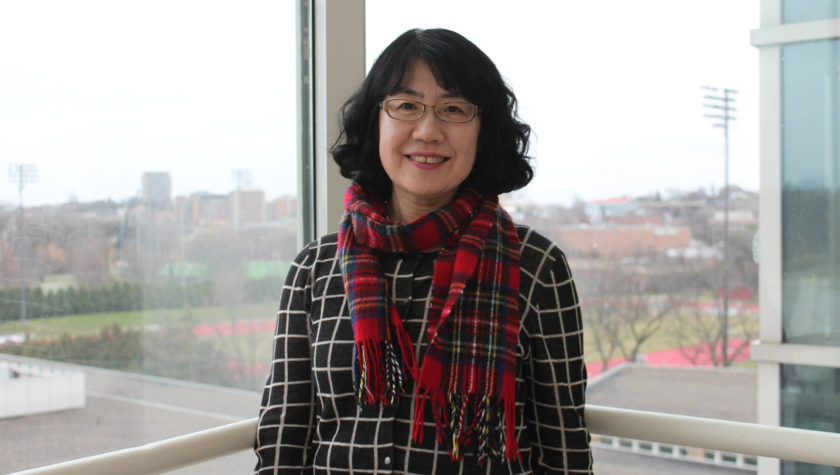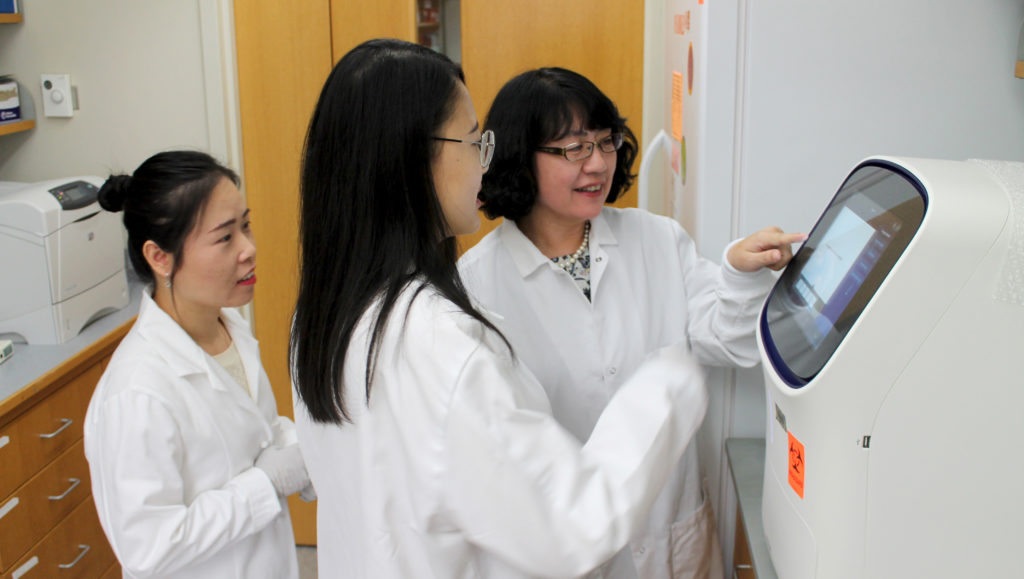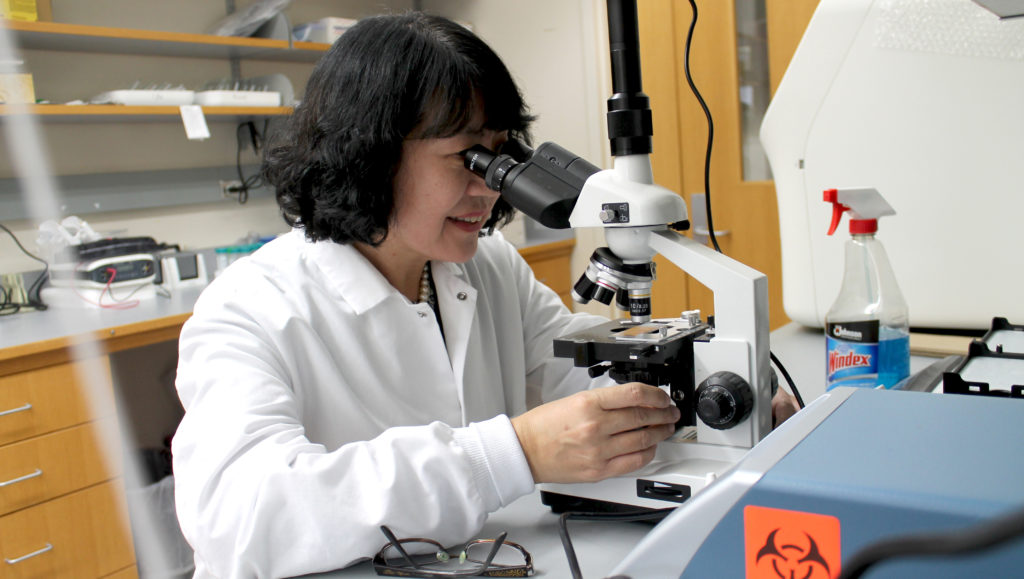
4
December

Assistant Professor Jun Dai explores the inner workings of skin to find new treatments for inflammation and cancer
By Nicole Etter
It’s easy to overlook our hardworking skin — the largest organ in the body. But its millions of cells continually work in concert to shield us from the insults of the outside world, standing sentry against invaders that might otherwise cause disease and infection.
And when something underneath the surface goes awry, our skin often sends up a visible distress signal, whether it’s an itchy red rash or a suspicious looking mole.
“Skin is the largest barrier between the body and the environment, and in addition to forming the physical barrier, it’s also a common site of inflammation because the skin is constantly exposed to chemical, physical, and pathological changes, like UV light, allergens, and microbes” explains Jun Dai, an assistant professor in the Pharmaceutical Sciences Division of the University of Wisconsin–Madison School of Pharmacy. Skin has a variety of cells and immune responses to fight against pathogens, and the first line of defense is inflammation.
A curiosity about how skin functions — and malfunctions — inspired Dai to turn her microscope’s focus from cell division to skin biology. Her research interests found a natural home at the UW–Madison School of Pharmacy, where she settled in 2017 after conducting research and teaching at Harvard Medical School and the School of Pharmaceutical Science and Technology at Tianjin University in China.
“My research is in line with the mechanisms of drug action, and my work at the School gives me the opportunity to work on more applied research,” says Dai, whose earlier work was supported by a K01 Career Development Award from the National Institutes of Health.
The School of Pharmacy is quite unique, she says, in that it allows her to combine her strengths in basic science with a focus on drug discovery and other research that could enhance patient care. As part of a large medical campus with several clinics and hospitals nearby, Dai is excited about the possibility of collaborating with clinicians to speed up the translation of her work on skin diseases and treatments from the bench to the bedside.

Understanding the inner workings of the skin
Dai studies the mechanisms underlying skin homeostasis, which is critical to preserving the skin’s strong line of defense.
The skin’s layers are populated with different cell types, which, during normal skin function, coordinate their actions. “Let’s say you have a cut or exposure to an allergen,” Dai says. “When the insult works past the barrier of the skin, the other cells underneath work together to fight against the insult.”
That initial barrier, the epidermis, is largely made up of keratinocytes, which are the focus of Dai’s research. Keratinocytes secrete chemicals that are important for the body’s immune response and replace the surface cells as they slough off. “The top layer constantly wears off and needs to be restored, so keratinocytes are really critical for the skin’s barrier function,” Dai explains.
But when genes mutate, that barrier can become compromised. Dai studies retinoid-related nuclear orphan receptors (RORs), a type of protein expressed in keratinocytes that plays an essential role in maintaining skin homeostasis and regulating the skin’s barrier function.
In search of better treatments for skin inflammation
Inflammation plays an important role in the skin’s defense system by increasing blood flow and attracting pathogen-fighting white blood cells to the damaged area. But too much inflammation can also cause problems.
“Under normal situations, all those immune cells are supposed to help protect against insults, but in a lot of skin diseases, they become over-reactive,” Dai explains. “That can cause an inflammatory response to conditions that the skin should be able to tolerate, and it becomes a vicious cycle.”
Chronic skin inflammation from conditions such as psoriasis and atopic dermatitis (also known as eczema) can cause more than just an annoying skin rash. Research shows that skin inflammation is associated with inflammation of internal organs, potentially leading to a host of other conditions ranging from heart disease to diabetes to Crohn’s disease.
While there are treatments for psoriasis and atopic dermatitis, they could be better, Dai notes. “You want to repair the barrier, so that’s one treatment strategy, and another is to use anti-inflammatory drugs,” she says. “For inflammation, we often use topical steroids, which are very effective, but they also have a lot of side effects, especially for long-term use.”
For example, topical steroids can cause severe atrophy, or skin thinning, which destroys the skin’s protective barrier.
Her lab has studied the potential of RORs as a drug target, and her work so far suggests that a nonsteroid topical treatment that targets RORs is effective in treating skin inflammation and restoring the skin’s barrier function — without the side effects of topical steroids. Now she’s trying to better understand how RORs function.
“We’re focusing on the mechanisms because we have a compound that seems promising, and we’re trying to work out which is the mechanism because it’s not well studied,” says Dai, who published her early findings in the Journal of Investigative Dermatology.

Better treatments for skin cancer
In addition to leading to better treatments for conditions like atopic dermatitis, Dai’s research could also have implications for wound healing and other skin conditions, including skin cancer. Normally only cells in the lower layer of the epidermis are able to divide, but when the genes that control skin cell growth mutate — as can happen with the DNA-damaging effects of ultraviolet light — cell growth can continue unchecked.
Dai’s research has also identified genes related to cell migration, which is an important factor in melanoma, the most serious form of skin cancer.
“Most skin cancers can be removed by surgery, but advanced melanoma can be very dangerous due to tumor metastasis,” she says. “In addition to targeting RORs, my other research interest is to study how tumor migration is controlled.”
Although Dai is still growing her lab at the School of Pharmacy, she is excited about the possibilities ahead and looks forward to building collaborations with dermatologists for future research projects.
“There really is a clinical need for newer and better treatments for skin conditions and cancers,” she says. “I look forward to my lab identifying and pushing those new strategies forward.”




